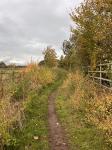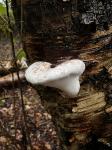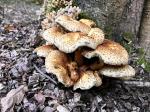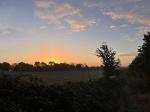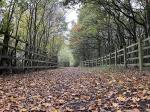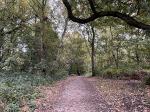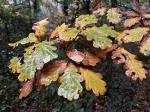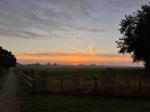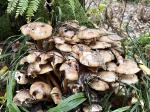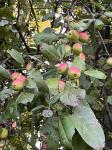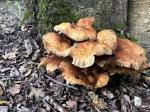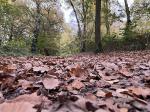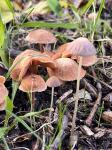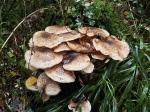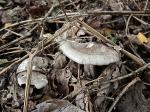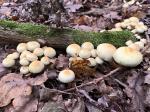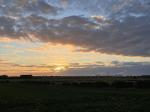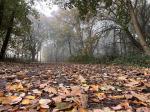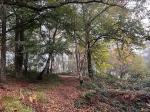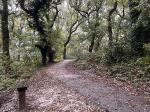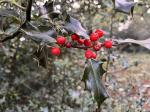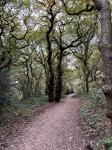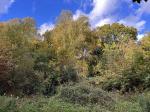Brayton Barff Through the Seasons.
Set in the Vale of York, South West of the market town of Selby and between the villages of Thorpe Willoughby and Brayton, lies Brayton Barff, a sandstone Hill approximately one hundred and fifty feet in height which was formed by glacial movement during the last Ice Age. It is a significant landmark in an otherwise flat landscape.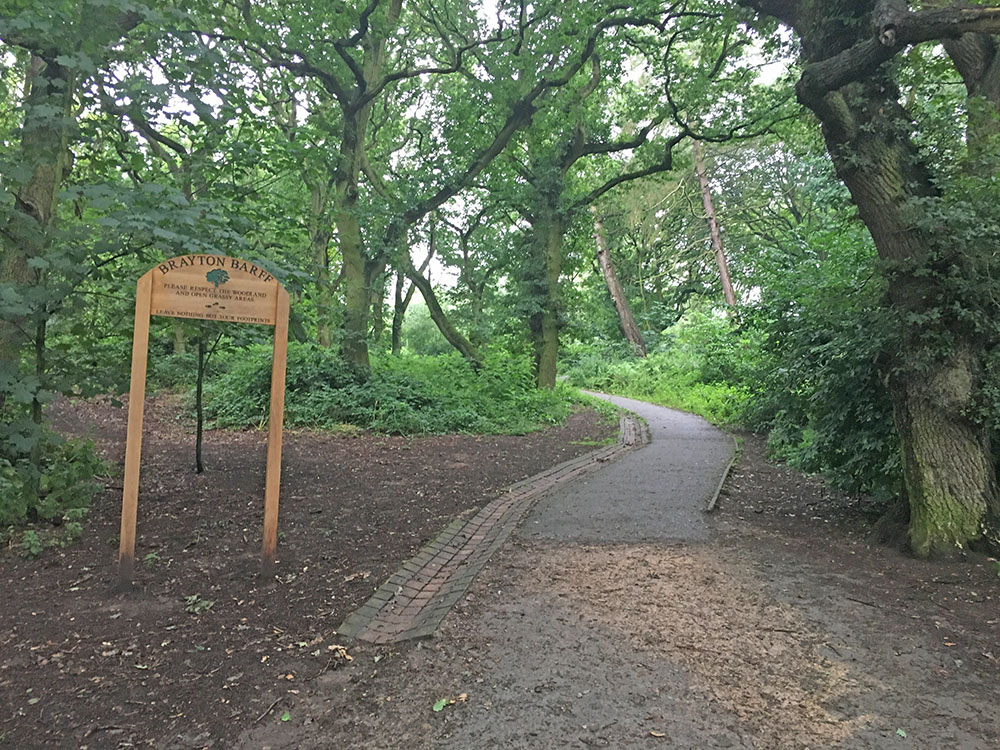
Today the site is primarily owned by Yorkshire Water with Selby District Council owning a small patch of the land adjacent to the A63 Selby bypass. A large underground reservoir occupies the centre of the site which delivers water to around 4.7 million customers throughout Yorkshire.
Within the Barff woodland over 40% of the trees are Sessile Oak which are generally found in semi natural woodlands in the north of the country. These trees are so called because its acorns are not held on stalks, like those of the English Oak (Pedunculate), but attached directly to the outer twigs. There are also several English Oak trees as well as some cross-hybrid oaks. These trees are known to support many species of flora and fauna, invertebrates, mosses, lichen and fungi.
During the Victorian times it is thought that the shipbuilders on the east coast would come over to the Barff for selected cuts of timber to build their sea going vessels.
The Barff also has a variety of other trees including Silver Birch, Beech, Sycamore, Holly, Rowan, Scots Pine, Alder, Hawthorne and European Larch. There are also several Yew, Willow, Hazel, Horse Chestnut and Wych Elm. As with similar woodlands there are a variety of bushes, including Honeysuckle, Elderberry, Gorse, Broom and Buddleia.
The history of Brayton Barff is quite vague, apparently during 1803 a beacon was lit on the Barff when the country was threatened with an invasion by Napoleon. In May 1935, to celebrate King George V's Silver Jubilee, a Bonfire was lit on the Barff as part of the celebrations.
Early issues of Ordnance Survey Maps dated 1903 clearly show a rifle range on the Barff, extending out to Mill Lane. During the 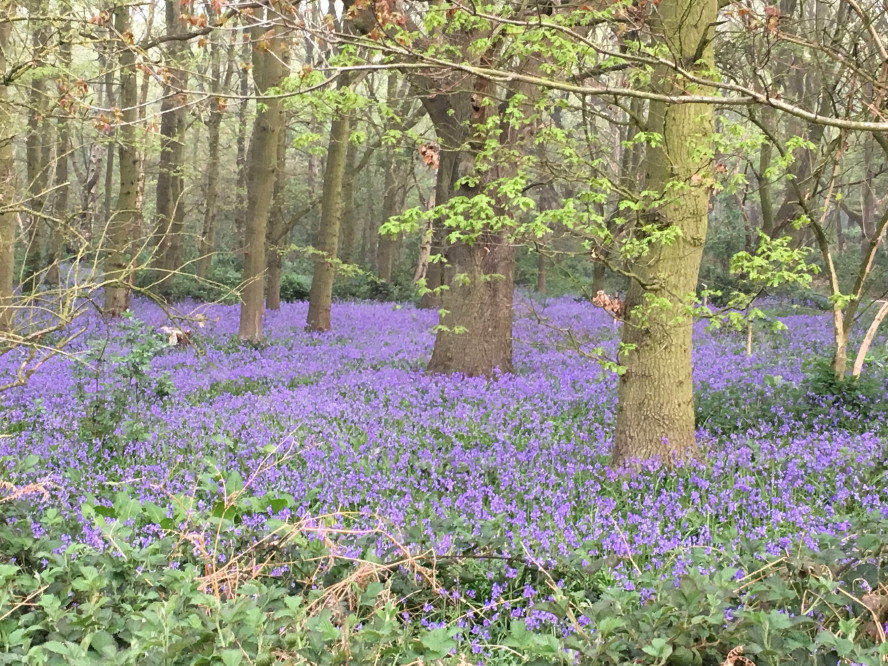
Between 2001 – 2004 the A63 Selby bypass, 10km twin lane single carriageway was constructed which severed the South West corner of the Barff, adjacent to Selby Golf Course and resulted in a slight redesign of several holes on the golf course. Wooden fencing was erected as a result of this new road running alongside of the Barff and a footbridge constructed over the ‘new road’ following the line of the Bridal way which extends from Mill Lane. Around 2005/2006 a definite 2metre wide limestone aggregate footpath was laid forming a circular path around the outer edges of the woodland. This footpath is approximately 1.2 miles in length and takes about 30 minutes to circumnavigate at a leisurely pace.
In 2012 the Barff was declared an Ancient Oak Woodland and as such throughout 2012 and 2013 significant work had been carried out by the relevant agencies to cut and remove large swathes of non-native trees, creating at that time huge scars on the landscape. Some three years later the planting of the native trees have become well established and are flourishing. Ongoing maintenance work on the footpath around the bottom of the Barff was completed during the Summer of 2016.
A second phase of woodland maintenance commenced during the Autumn of 2019 with the removal of many old and diseased trees and the cutting back of the Gorse and Broom bushes, especially adjacent to the ‘bypass trail’, this work continued through till March 2020 with re planting continuing into April 2020.
Brayton Barff is a popular site for walkers and bird watchers alike and a path circling the outer perimeter of the Barff makes a pleasant thirty minute walk, giving views looking over towards Selby and the village of Brayton as well as the power stations of Drax and Eggborough..jpg)
For the early risers it is a great place to see some stunning sunrises over the villages of Brayton looking towards Drax Power Station, the same with the Sunsets looking over towards Eggborough and Monk Fryston.
The Barff changes with the Seasons and every visit can reveal something new, the woodland is a haven for wildlife. Records show that since 1982 one hundred and twelve species of bird have been seen in the woodland and at least 40 of those have bred here, including Tawny Owl, Buzzard, Green Woodpecker, Spotted Flycatcher, Goldcrest and Nuthatch to name just a few. On average over 70 species of bird are recorded each year. Further details of the bird life on the Barff can be found on the Brayton Barff Group Facebook page, especially the posts from Derek Cooper. Today ‘The Friends of Brayton Barff group’ led by Derek and a small team of volunteers help keep and maintain the cleanliness of the site as well as recording the wildlife and bird sightings.
The Barff is also home to fifteen different species of mammals, including Muntjac Deer, Pipistrelle Bat, Fox, and Field Vole.
Over eighty species of plant and wildflowers have been recorded, included Bee Orchid, Northern Marsh Orchid, Wood Anemone, Marsh Ragwort, Bluebell, White Bluebell, Bittersweet and Purple and White Foxgloves. Over twenty species of Butterfly have been recorded, including Marbled White, Brown Angus, Speckled Wood, Comma and Brimstone.
During the Autumnal months fungi thrives in this woodland environment, species including Fly Agaric, Beefsteak Tree Fungi, Chicken of the Wood, Sulphur Tufts, Stinkhorn, Ink cap, Puffballs and Hoof Bracket are just some of the many varieties that can be found here.
Click on the galleries shown below to expand the albums.
October 2024
I always enjoy this time of year on the Barff, especially seeing the autumnal colours, and the different fungi that appears to pop up overnight amongst the woodland undergrowth.
October has been another wet month on the Barff, with twice as much rainfall recorded than is usual for this time of year, the ground has barely had chance to dry out. Most of my morning visits to the Barff weatherwise have been dull, cloudy and overcast with the sun only appearing much later in the morning if at all.
We have seen just a handful of light early morning frosts, otherwise the temperature has been around 10-12c for most of the time, warming up slightly during the afternoon to between 13-15c.
We have had several yellow weather warnings for rain and winds which did not really materialise. We caught the back end of ‘Storm Ashley’ last weekend, classified as the first storm of the Autumn, other than some strong westerly winds it did not really affect this part of North Yorkshire.
Many of our Summer visiting birds like the Garden & Willow Warblers, Chiffchaffs and Blackcaps have now left the woodland for warmer climes whilst we await in earnest for the Fieldfares, Redwing and Mistle Thrush which tend to over winter here on the Barff. The Buzzard continues to be very vocal around the woodland and will be overwintering amongst the trees again this year, I hope. They are now the most common and widespread Bird of Prey in the country and this habitat with a healthy and varied diet of carrion, earthworms, and voles, should see them through the colder winter months. I am hoping that in the not-too-distant future we might start to see the Red Kites encroaching on to the Barff, they have a very similar diet to the Buzzards, I often see them circling above our house and I live just a 15-minute walk from the woodland.
Robins, Wrens Chaffinch, Great, Blue and Long Tailed Tits and Goldcrest can be seen and heard most days around the woodlands and Bullfinches are showing nicely close to the car park. Long Tailed Tits seem to be comfortably settled in the hedges along the Bypass trail and a pair of Jays seem to be quite settled on the top paddock, I often stop and watch them as they squabble with each other. As the month draws to a close, I have seen and heard several skeins of Pink Footed Geese flying over the woodland heading for the watering holes at Barlow and Fairburn. These beautiful big birds’ nest in Iceland and migrate to the UK about now to spend the winter months here in our milder climate, only returning to Iceland and their breeding grounds towards the end of April
Blackbirds, Woodpigeons and Collard Doves are a permanent feature and can be seen and heard foraging amongst the leaf litter most days
As I mentioned earlier the trees have been the stars of the show this Autumn, leaves that were intense green, burst into a fiery palette of yellows, oranges, reds, and russet browns. Then, as the ambers of autumn die down, this foliage finally separates from its parent tree and tumbles to the woodland floor.
A dazzling display of gold and crimson leaves is one of the defining features of autumn for me. It is not just the trees though; the ferns are also turning a vibrant golden-brown colour too. This annual event is triggered by autumn’s cooler temperatures and shorter days. When there is less sunlight, deciduous trees stop producing chlorophyll, which they use to convert light into energy to grow. Chlorophyll is the pigment that gives leaves their green colour. When production slows down, the chlorophyll fades and yellow and red pigments are revealed, producing the colours we see today. Even on a dull, cloudy, and overcast morning the trees look good, when the sunshine’s though they look even better.
October has seen an abundance of fungi on the Barff, Sulphur Tuft, Common Puffball, Shaggy Parasol, Turkey Tail and Hoof Bracket to name just a few of the more common seen species, then there are the ones which are a little more difficult to find like the Deadman fingers, Chicken of the Woods, Common Stinkhorn and Fly Agaric. There are approximately 1500 different species of fungi in this country, and each plays a pivotal role in our ecosystem by recycling waste and breaking down organic materials like leaves and wood into new nutrients, helping plants and trees to grow and thrive. In fact, the existence of 95 per cent of plants relies on fungi. New species of fungi are appearing on a frequent basis on the Barff and the interesting part of discovering them is to correctly identify them.
The colourful Teasels with their purple lilac coloured seed heads have died back and are now providing a useful seed source for Goldfinch and may other birds.
Sadly, it has been a poor year for the Acorns, with very few being seen on the Oak trees, this is not uncommon as the trees are still busily building up their reserves from last year’s bumper crop. I was reading an interesting article recently stating experiments have shown that of a relatively small oak trees 14,000 fallen acorns, only 20 will successfully germinate and turn into healthy seedlings. A poor summer harvest of acorns could spell disaster for the Grey Squirrel population and the Jays to some extent, let’s hope they are resourceful enough to get through the next three months.
|



